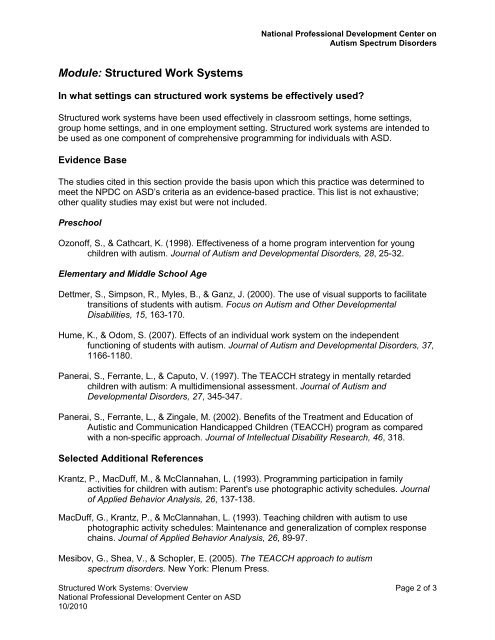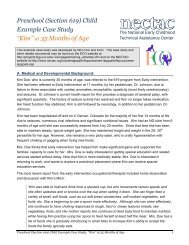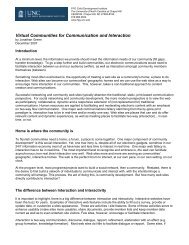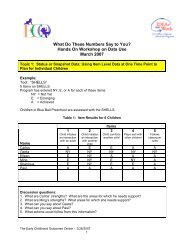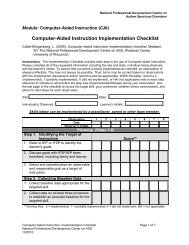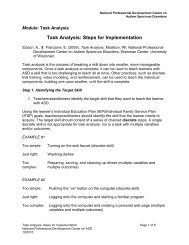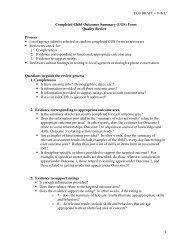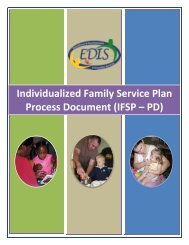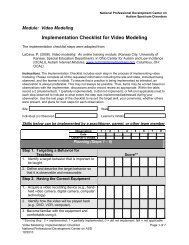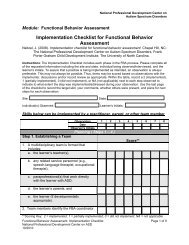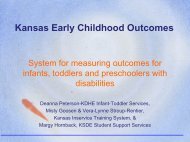Overview of Structured Work Systems - National Professional ...
Overview of Structured Work Systems - National Professional ...
Overview of Structured Work Systems - National Professional ...
You also want an ePaper? Increase the reach of your titles
YUMPU automatically turns print PDFs into web optimized ePapers that Google loves.
<strong>National</strong> Pr<strong>of</strong>essional Development Center on<br />
Autism Spectrum Disorders<br />
Module: <strong>Structured</strong> <strong>Work</strong> <strong>Systems</strong><br />
In what settings can structured work systems be effectively used<br />
<strong>Structured</strong> work systems have been used effectively in classroom settings, home settings,<br />
group home settings, and in one employment setting. <strong>Structured</strong> work systems are intended to<br />
be used as one component <strong>of</strong> comprehensive programming for individuals with ASD.<br />
Evidence Base<br />
The studies cited in this section provide the basis upon which this practice was determined to<br />
meet the NPDC on ASD’s criteria as an evidence-based practice. This list is not exhaustive;<br />
other quality studies may exist but were not included.<br />
Preschool<br />
Ozon<strong>of</strong>f, S., & Cathcart, K. (1998). Effectiveness <strong>of</strong> a home program intervention for young<br />
children with autism. Journal <strong>of</strong> Autism and Developmental Disorders, 28, 25-32.<br />
Elementary and Middle School Age<br />
Dettmer, S., Simpson, R., Myles, B., & Ganz, J. (2000). The use <strong>of</strong> visual supports to facilitate<br />
transitions <strong>of</strong> students with autism. Focus on Autism and Other Developmental<br />
Disabilities, 15, 163-170.<br />
Hume, K., & Odom, S. (2007). Effects <strong>of</strong> an individual work system on the independent<br />
functioning <strong>of</strong> students with autism. Journal <strong>of</strong> Autism and Developmental Disorders, 37,<br />
1166-1180.<br />
Panerai, S., Ferrante, L., & Caputo, V. (1997). The TEACCH strategy in mentally retarded<br />
children with autism: A multidimensional assessment. Journal <strong>of</strong> Autism and<br />
Developmental Disorders, 27, 345-347.<br />
Panerai, S., Ferrante, L., & Zingale, M. (2002). Benefits <strong>of</strong> the Treatment and Education <strong>of</strong><br />
Autistic and Communication Handicapped Children (TEACCH) program as compared<br />
with a non-specific approach. Journal <strong>of</strong> Intellectual Disability Research, 46, 318.<br />
Selected Additional References<br />
Krantz, P., MacDuff, M., & McClannahan, L. (1993). Programming participation in family<br />
activities for children with autism: Parent's use photographic activity schedules. Journal<br />
<strong>of</strong> Applied Behavior Analysis, 26, 137-138.<br />
MacDuff, G., Krantz, P., & McClannahan, L. (1993). Teaching children with autism to use<br />
photographic activity schedules: Maintenance and generalization <strong>of</strong> complex response<br />
chains. Journal <strong>of</strong> Applied Behavior Analysis, 26, 89-97.<br />
Mesibov, G., Shea, V., & Schopler, E. (2005). The TEACCH approach to autism<br />
spectrum disorders. New York: Plenum Press.<br />
<strong>Structured</strong> <strong>Work</strong> <strong>Systems</strong>: <strong>Overview</strong> Page 2 <strong>of</strong> 3<br />
<strong>National</strong> Pr<strong>of</strong>essional Development Center on ASD<br />
10/2010


